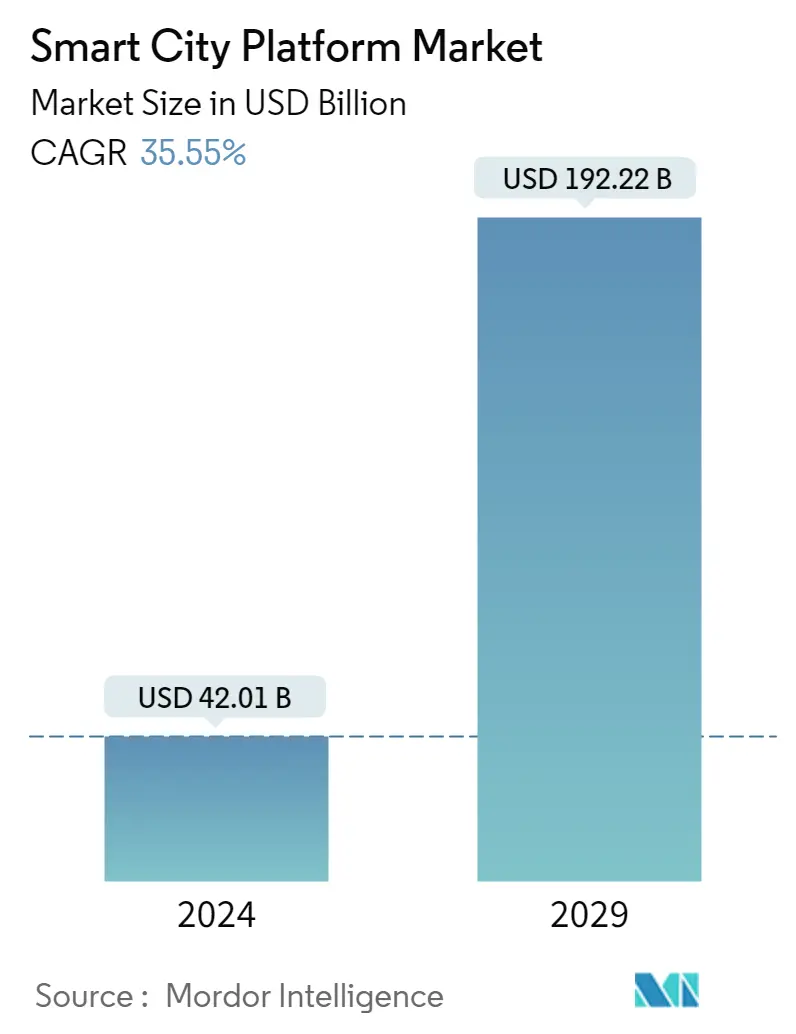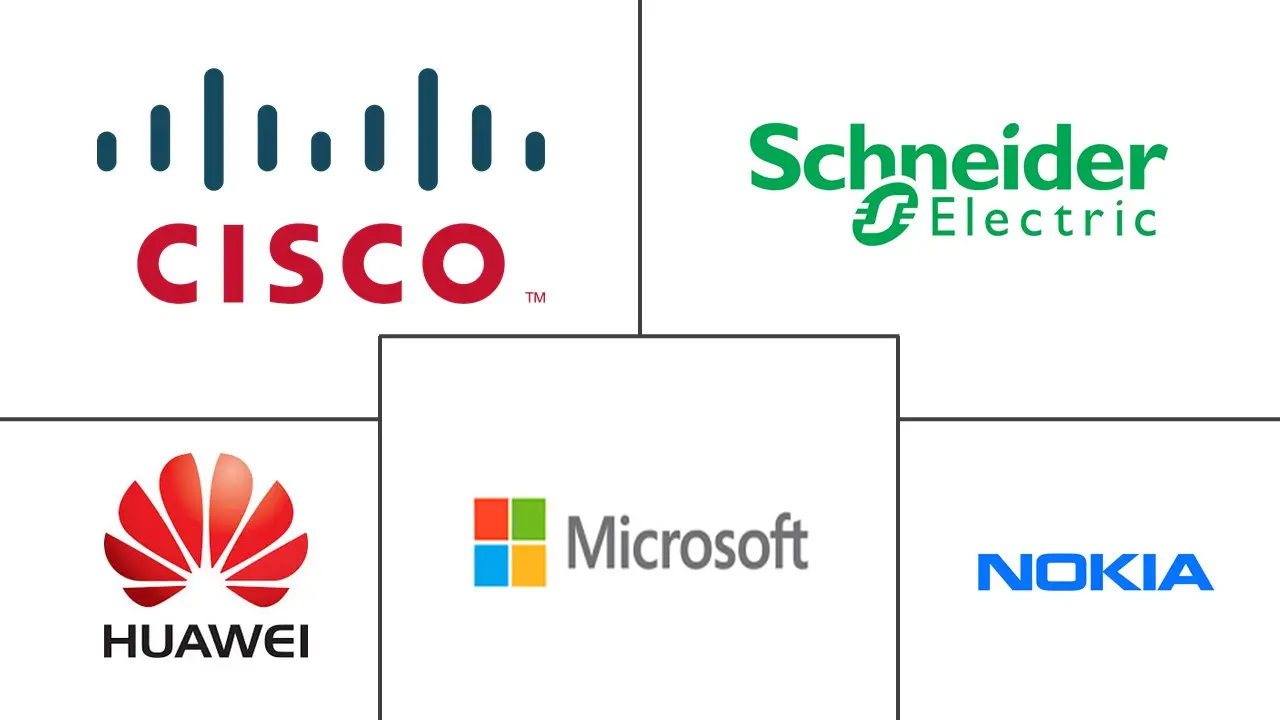Market Size of Smart City Platform Industry

| Study Period | 2019 - 2029 |
| Market Size (2024) | USD 42.01 Billion |
| Market Size (2029) | USD 192.22 Billion |
| CAGR (2024 - 2029) | 35.55 % |
| Fastest Growing Market | Asia Pacific |
| Largest Market | North America |
| Market Concentration | Low |
Major Players
*Disclaimer: Major Players sorted in no particular order |
Smart City Platforms Market Analysis
The Smart City Platform Market size is estimated at USD 42.01 billion in 2024, and is expected to reach USD 192.22 billion by 2029, growing at a CAGR of 35.55% during the forecast period (2024-2029).
The COVID-19 pandemic heightened the need to invest in connectivity infrastructure and solutions that alleviate public health and safety concerns. The demand for safe and secure transport and connected applications rose to make systems safer by providing real-time warnings about crowding, access problems, or delays to help people make better informed public travel decisions.
- Smart cities are growing globally due to urbanization, which is enabling market growth. According to projections by the United Nations, in India, 404 million, China, 292 million, and Nigeria, 212 million urban dwellers are expected to be added to the existing populations by 2050.
- The government initiatives and spending are also giving much more significance to platform providers than standalone smart solutions because of the scalability and integration of other smart solutions. For instance, as of January 2022, the Indian government has released INR 28,413.6 crore for 100 smart cities.
- Smart city platforms perform various functions, such as analytics, remote asset monitoring, performance management, decision support, or presentation components. Most technologically advanced cities use the Internet of Things platform to monitor city infrastructure, manage traffic flows and parking to water and air quality, and use the resulting smart data to tackle longer-term planning decisions around environmental sustainability.
- The smart city platforms offer a foundation for urban infrastructure, applications, services, and various city-specific functions. One of the significant factors expected to drive the market's growth in cities is giving priority to platform providers compared to standalone smart solutions because of the scalability and integration of other smart solutions.
- As smart city projects across the world have grown and have taken up the pace, the primary vision, the technologies, and the realities on the ground level have become layered and more complex to deal with. Furthermore, to simplify these complexities, the market will witness a strong drive toward the usage of more intuitive processes, which includes the increased adoption of machine learning solutions to gather and analyze the huge amount of generated data.
Smart City Platforms Industry Segmentation
A smart city platform provides the integrated capability to transform the urban infrastructure and services by deploying IoT, solutions, and other technologies. It helps to coordinate data, applications, and services at one or more levels across operational domains for multiple stakeholders. A smart city platform strategy leverages AI, blockchain, and sensor data crowdsourcing in the smart city IoT platform environment.
The Smart City Platform Market is segmented by Platform Type (Connectivity Management Platform, Integration Platform, Device Management Platform, Data Management Platform, Security Management Platform), Application (Smart Mobility/Transportation, Smart Security, Smart Utilities, Smart Governance, Smart Infrastructure, Smart Healthcare), Deployment (On-premise, Cloud), and Geography.
| Platform Type | |
| Connectivity Management Platform | |
| Integration Platform | |
| Device Management Platform | |
| Data Management Platform | |
| Security Management Platform |
| Application | |
| Smart Mobility/Transportation | |
| Smart Security | |
| Smart Utilities | |
| Smart Governance | |
| Smart Infrastructure | |
| Smart Healthcare | |
| Other Applications |
| Deployment | |
| On-premise | |
| Cloud |
| Geography | |
| North America | |
| Europe | |
| Asia Pacific | |
| Latin America | |
| Middle East and Africa |
Smart City Platform Market Size Summary
The Smart City Platform Market is experiencing significant growth, driven by the increasing urbanization and the need for enhanced connectivity infrastructure. The COVID-19 pandemic has further accelerated the demand for smart city solutions, as cities seek to improve public health and safety through connected applications and real-time data analytics. Governments worldwide are prioritizing platform providers over standalone solutions due to the scalability and integration benefits these platforms offer. Smart city platforms are becoming integral to urban infrastructure, enabling cities to manage resources more efficiently and address challenges such as traffic management, environmental sustainability, and citizen engagement. The adoption of advanced technologies like the Internet of Things (IoT) and machine learning is simplifying the complexities of urban management, facilitating better decision-making and service delivery.
North America leads the smart city platform market, supported by substantial ICT investments and a strong presence of key vendors. The region's focus on leveraging IoT technologies to enhance urban living conditions is evident in initiatives like Digital Twin technology and smart poles for improved urban infrastructure. The market is highly competitive, with companies investing heavily in research and development to innovate and capture market share. Strategic partnerships and collaborations, such as those between Microsoft and the Manila Municipal Government, and Nokia's initiatives in Nicosia, are driving the expansion of smart city solutions globally. These developments underscore the growing importance of smart city platforms in addressing urban challenges and promoting sustainable development.
Smart City Platform Market Size - Table of Contents
-
1. MARKET DYNAMICS
-
1.1 Market Overview
-
1.2 Market Drivers
-
1.2.1 Rising Adoption of Internet and IoT Devices
-
1.2.2 Governments Increasing Focus on Smart City
-
-
1.3 Market Restraints
-
1.3.1 Governments Increasing Focus on Smart City
-
-
1.4 Value Chain / Supply Chain Analysis
-
1.5 Industry Attractiveness - Porter's Five Forces Analysis
-
1.5.1 Bargaining Power of Suppliers
-
1.5.2 Bargaining Power of Consumers
-
1.5.3 Threat of New Entrants
-
1.5.4 Threat of Substitutes
-
1.5.5 Intensity of Competitive Rivalry
-
-
-
2. MARKET SEGMENTATION
-
2.1 Platform Type
-
2.1.1 Connectivity Management Platform
-
2.1.2 Integration Platform
-
2.1.3 Device Management Platform
-
2.1.4 Data Management Platform
-
2.1.5 Security Management Platform
-
-
2.2 Application
-
2.2.1 Smart Mobility/Transportation
-
2.2.2 Smart Security
-
2.2.3 Smart Utilities
-
2.2.4 Smart Governance
-
2.2.5 Smart Infrastructure
-
2.2.6 Smart Healthcare
-
2.2.7 Other Applications
-
-
2.3 Deployment
-
2.3.1 On-premise
-
2.3.2 Cloud
-
-
2.4 Geography
-
2.4.1 North America
-
2.4.2 Europe
-
2.4.3 Asia Pacific
-
2.4.4 Latin America
-
2.4.5 Middle East and Africa
-
-
Smart City Platform Market Size FAQs
How big is the Smart City Platform Market?
The Smart City Platform Market size is expected to reach USD 42.01 billion in 2024 and grow at a CAGR of 35.55% to reach USD 192.22 billion by 2029.
What is the current Smart City Platform Market size?
In 2024, the Smart City Platform Market size is expected to reach USD 42.01 billion.

